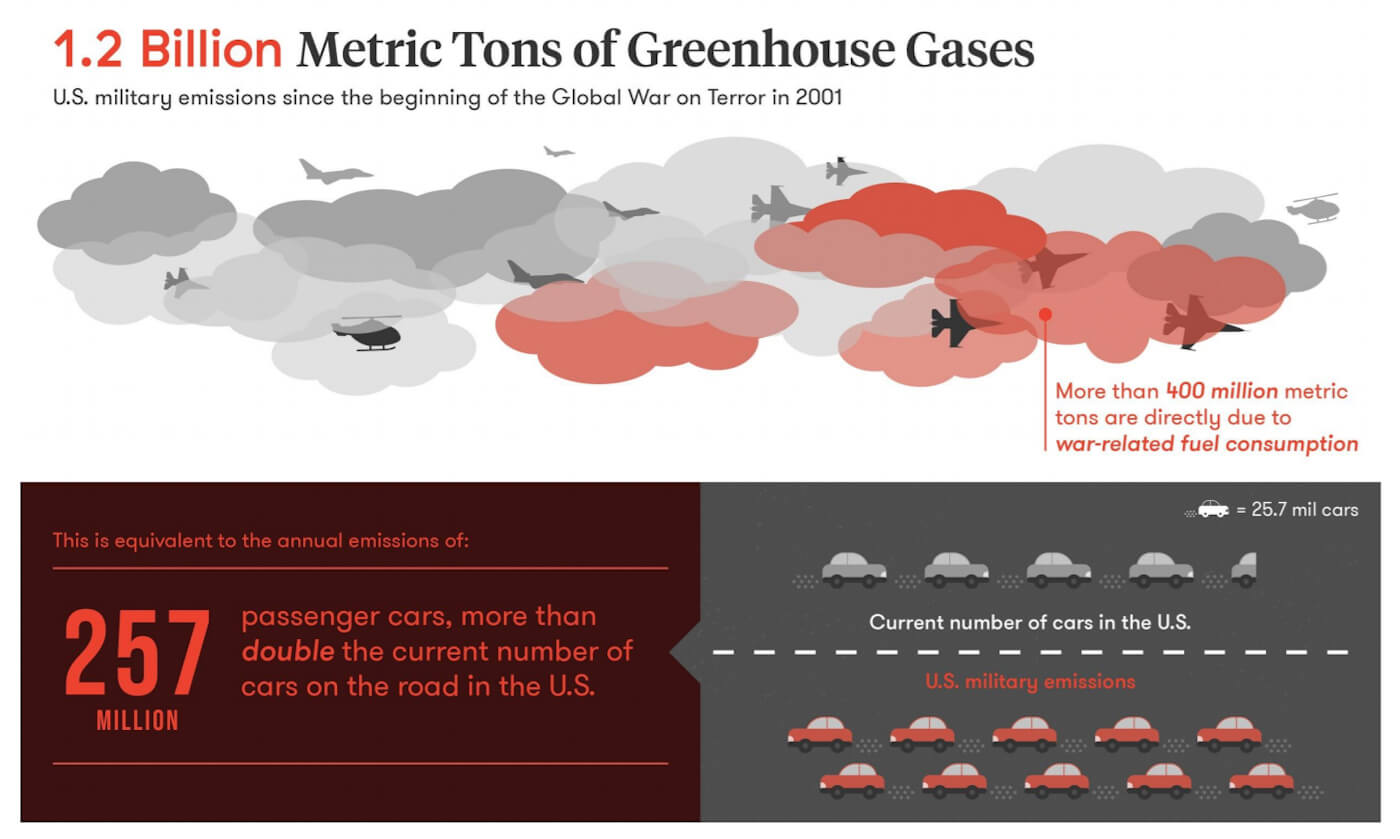Shadowproof — The United States military has emitted over a billion metric tons of greenhouse gases since the beginning of the global war on terrorism in 2001, according to a report from Brown University’s “Costs of War” project.
It is equivalent to the annual emissions of 257 million passenger cars, “more than double the current number of cars on the road in the U.S.”
With over 800 military bases in more than 80 countries, the Pentagon remains the “world’s largest institutional user of petroleum” and “producer of greenhouse gases.”
The Pentagon is not transparent when it comes to fuel consumption or greenhouse gas emissions. However, the project used the Department of Energy’s emissions data for the report’s estimates.
In 2017, the Pentagon’s greenhouse gas emissions were about 59 million metric tons. That same year, this was more than Finland (46.8 million metric tons), Sweden (50.8 million metric tons), or Denmark (33.5 million metric tons).
At least 400 million metric tons of greenhouse gases are a result of consumption in war zones in Afghanistan, Pakistan, Iraq, and Syria.
According to the report, “From 1998 to 2017, the U.S. purchased 2.4 billion barrels of petroleum fuel. Since the 9/11 attacks, annual fuel purchases have averaged more than 120 million barrels of all types of fuel. Between 2010 and 2015, the armed services purchased an average of 102 million barrels of fuel per year from the DOD.”
It is estimated the Pentagon consumed more than 85 million barrels of “operational fuel” in order to power its fleets of ships, aircraft, and combat vehicles. They also used the fuel for “contingency bases.” In total, $8.2 billion was spent.
Since 2001, the [Pentagon] has consistently consumed between 77 and 80 percent of all U.S. government energy consumption,” the report notes.
Installations that support operations, as well as military non-armored vehicles, are notorious in their guzzling of fuel. There are apparently 60,000 HUMVEEs that remain the U.S. Army’s fleet. They get about “four to eight miles per gallon of diesel fuel.”
Domestic and overseas military installations account for about 40 percent of the Pentagon’s greenhouse gas emissions.
The report briefly details how jet fuel is a major source of greenhouse gas emissions.

Aircraft are responsible for hundreds of tons of C02. Wars in Iraq and Afghanistan involved massive airstrikes, and materials were flown to setup bases for occupations.
“Similarly, the U.S. war against ISIS in Syria and Iraq, which began in August 2014, has entailed tens of thousands of aircraft sorties for various missions—from reconnaissance, to airlift, refueling, and weapons strikes. A B-2 Bomber on a mission from Whiteman Air Force Base in Missouri might be refueled many times.
The project cites the following example from January 18, 2017: “Two B-2 Bombers, accompanied by 15 KC-135 and KC-10 aerial refueling tankers made a 30-hour round trip mission from Whiteman Air Force Base to Libya to drop bombs on ISIS targets in Libya.”
As the report mentions, the project did not account for emissions caused by the “burning of oil by sabotage” or the destruction of oil infrastructure. Nor did it account for energy consumed in the process of reconstruction efforts or the impact of deforestation.
“In Afghanistan, war-caused migration and illegal logging appear to be the chief cause of deforestation. The causes of deforestation in Iraq are complex but include war.”
While the U.S. military has plenty of resources to move to renewable energy, it has remained dependent on petroleum, which is a boon for the oil and gas industry.
Switches to renewable power generation between 2011 and 2015 have only offset less than one percent of the Pentagon’s greenhouse gas emissions.
The closure of U.S. military bases in addition to the end of wars would go a long way toward diminishing the U.S. government’s gigantic carbon footprint. Any plan to address climate change should contemplate demilitarization, given what is outlined in this report.
As Alice Slater, the New York director of the Nuclear Age Peace Foundation, wrote for The Nation, U.S. military bases are not only responsible for such massive amounts of greenhouse emissions but also devastating impacts caused by pollutants and toxic weapons.
“From Agent Orange in Vietnam, depleted uranium in Iraq, and munitions dumps and firing ranges in Vieques, Puerto Rico, to a toxic brew of poisons along the Potomac River, communities and soldiers as well as children born subsequent to exposure to these toxins are suffering a broad range of illnesses and inherited genetic damage, while the U.S. government ducks any accountability for the harm caused by its mindless dumping and reckless burial of untreated toxic military wastes,” Slater described.
Countries in Latin America, Africa, and Asia that have been impacted the most have been largely unable to convince or pressure the U.S. military into funding clean-up projects.
When one adds the toxic effects of U.S. military bases to the enormous amount of emissions over the past couple decades, it becomes clear a climate plan should include climate reparations for affected countries too.
Feature photo | U.S. Army Reserve Soldiers during a training exercise in Fort Irwin, Calif., June 10, 2019. Photo | Dvids
Kevin Gosztola is managing editor of Shadowproof Press. He also produces and co-hosts the weekly podcast, “Unauthorized Disclosure.“
Source | Shadowproof


